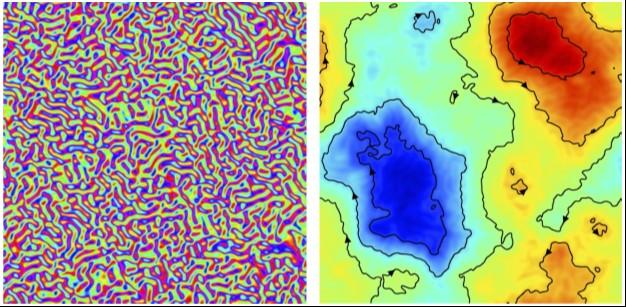
Credit: R. Alert et al.
Turbulent flows are chaotic yet feature universal statistical properties.Over the recent years, seemingly turbulent flows have been discovered in active fluids such as bacterial suspensions, epithelial cell monolayers, and mixtures of biopolymers and molecular motors. In a new study published in Nature Physics, researchers from the University of Barcelona, Princeton University and Collège de France have shown that the chaotic flows in active nematic fluids are described by distinct universal scaling laws.
Turbulence is ubiquitous in nature, from plasma flows in stars to large-scale atmospheric and oceanic flows on Earth, through air flows caused by an airplane. Turbulent flows are chaotic, creating eddies that appear and break into smaller swirls constantly. However, when this complex chaotic behavior is considered in a statistical sense, turbulence follows universal scaling laws. This means that the statistical properties of turbulence are independent in both the way in which turbulent flows are generated, and the properties of the specific fluid that we look at, such as its viscosity and density.
In the study now published in Nature Physics, researchers have revisited this notion of universality in the context of active fluids. In active turbulence, flows and eddies are not generated by the action of some external agent (such as temperature gradients in the atmosphere) but rather by the active fluid itself. The active nature of these fluids relies on their ability to internally generate forces, for example due to the swimming of bacteria or the action of molecular motors on biopolymers.
“When these active forces are sufficiently strong, the fluid starts to spontaneously flow, powered by the energy injected by the active processes” explains Ricard Alert, postdoctoral fellow at Princeton University. When active forces are strong, these spontaneous flows become a chaotic mix of self-generated eddies ? what we call active turbulence.
The authors focused on a specific type of active fluid: two-dimensional active nematic liquid crystals, which describe experimental systems such as cell monolayers and suspensions of biopolymers and molecular motors. Large-scale simulations showed that the active flows organize into a disordered pattern of eddies of a characteristic size (Fig. 1, Left). The researchers then studied the flows at much larger scales than the characteristic size of the eddies (Fig. 1, Right). They found that the statistical properties of these large-scale flows follow a distinct scaling law.
“We showed that this scaling law is universal, independent of the specific properties of the active fluid” points out Professor Jaume Casademunt from the Institute of Complex Systems (UBICS) of the University of Barcelona. This scaling law is the equivalent in active nematic fluids of Andrei Kolmogorov’s 1941 scaling law for classic turbulence, but with a different exponent that results from the combination of inertia-less viscous flows and the internal, self-organized forcing of active fluids.
Another striking result of this research is that all the energy that is injected by the active forces at a given scale is dissipated by viscous effects at that same scale. As a consequence, in stark contrast to classic turbulence, no energy is left to be transferred to other scales. “Both in simulations and analytically, researchers proved that a minimal active nematic fluid self-organizes in a way such that the active energy injection exactly balances energy dissipation at each scale” concludes Jean-François Joanny, from the Collège de France.
###
Article reference:
R. Alert, J-F. Joanny, and J. Casademunt. “Universal scaling of active nematic turbulence”. Nature Physics. DOI: https:/
Media Contact
Bibiana Bonmatí
[email protected]
Original Source
https:/




